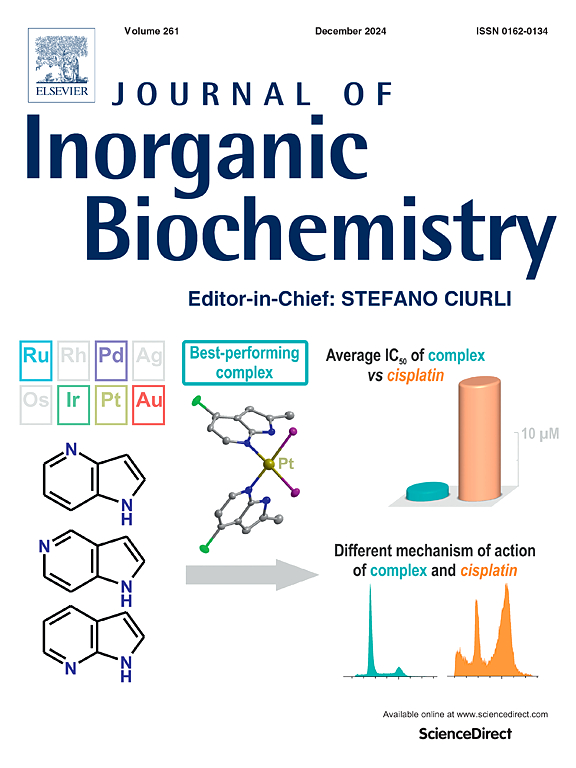两种多功能零维Gd(III)配合物:肺癌的磁热效应和抗癌机制。
IF 3.8
2区 化学
Q2 BIOCHEMISTRY & MOLECULAR BIOLOGY
引用次数: 0
摘要
以希夫碱为配体合成了两个Gd(III)配合物[GdL(H2O)(NO3)2(CH3OH)0.75(CH3CH2OH)0.25] (Gd1)和[Gd2(OOCCH3)2L2(H2O)6]•2(H2O) (Gd2) (HL = 2-吡啶基甲醛异烟碱腙)。晶体学研究表明Gd1和Gd2均具有零维单核或双核结构。磁性研究表明,由于Gd(III)离子的存在,Gd1和Gd2表现出潜在的磁热效应,其磁各向异性可以忽略不计,并且具有低激发自旋态。Gd1和Gd2对3种肿瘤细胞系的抗增殖活性测定结果显示,Gd1和Gd2对A549细胞的抗增殖活性明显优于顺铂。Gd1和Gd2的处理导致A549细胞凋亡呈浓度依赖性增加,同时细胞内活性氧(ROS)水平相应升高。此外,Gd1和Gd2能够显著抑制肿瘤细胞的迁移。细胞周期测定显示A549细胞的细胞周期阻滞在G0/G1期。Western blotting分析显示,Gd1和Gd2复合物可通过调节Bcl-2和Bax蛋白的表达促进A549细胞凋亡。本文章由计算机程序翻译,如有差异,请以英文原文为准。

Two multifunctional zero-dimensional Gd(III) complexes: magnetocaloric effect and anticancer mechanisms for lung cancer
Two Gd(III) complexes [GdL(H2O)(NO3)2(CH3OH)0.75(CH3CH2OH)0.25] (Gd1) and [Gd2(OOCCH3)2L2(H2O)6]•2(H2O) (Gd2) (HL = 2-pyridylcarboxaldehyde isonicotinoylhydrazone) were synthesized with a Schiff base ligand. Crystallographic study reveals both Gd1 and Gd2 have a zero-dimensional mononuclear or binuclear structure. Magnetic investigations demonstrate that Gd1 and Gd2 exhibit potential magnetocaloric effects due to Gd(III) ions, which provide negligible magnetic anisotropy, and possess low-lying excited spin states. The antiproliferative activity of Gd1 and Gd2 to three tumor cell lines was conducted and the results showed Gd1 and Gd2 showed more pronounced antiproliferative activity to A549 cells better than cisplatin. The administration of Gd1 and Gd2 led to an increase in apoptosis among A549 cells in a concentration-dependent manner, along with a corresponding rise in the levels of reactive oxygen species (ROS) within the cells. Besides, Gd1 and Gd2 were able to significantly inhibit tumor cell migration. Cell cycle assay in A549 cells revealed that cell cycle was arrested of G0/G1 phase. Western blotting analysis showed that Gd1 and Gd2 complexes could promote apoptosis in A549 cells by modulating the expression of Bcl-2 and Bax proteins.
求助全文
通过发布文献求助,成功后即可免费获取论文全文。
去求助
来源期刊

Journal of Inorganic Biochemistry
生物-生化与分子生物学
CiteScore
7.00
自引率
10.30%
发文量
336
审稿时长
41 days
期刊介绍:
The Journal of Inorganic Biochemistry is an established international forum for research in all aspects of Biological Inorganic Chemistry. Original papers of a high scientific level are published in the form of Articles (full length papers), Short Communications, Focused Reviews and Bioinorganic Methods. Topics include: the chemistry, structure and function of metalloenzymes; the interaction of inorganic ions and molecules with proteins and nucleic acids; the synthesis and properties of coordination complexes of biological interest including both structural and functional model systems; the function of metal- containing systems in the regulation of gene expression; the role of metals in medicine; the application of spectroscopic methods to determine the structure of metallobiomolecules; the preparation and characterization of metal-based biomaterials; and related systems. The emphasis of the Journal is on the structure and mechanism of action of metallobiomolecules.
 求助内容:
求助内容: 应助结果提醒方式:
应助结果提醒方式:


